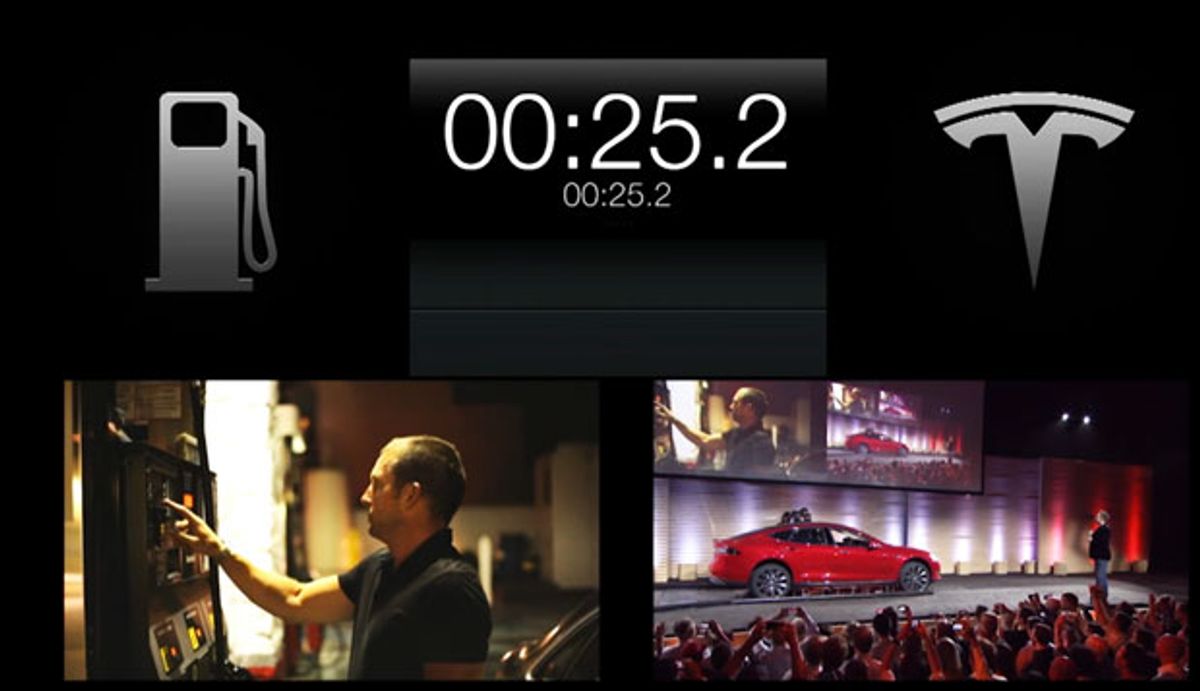Less than a month after Better Place's bankruptcy filing—which seemed to be the kiss of death for the vision of an automotive future in which owners of electric cars would switch out their batteries rather than recharge them—high-flying Tesla Motors has revived the idea. In a press event Thursday evening, Tesla's somewhat oddly attired Elon Musk showed how the the company's Tesla S luxury sedan could be recharged in just 90 seconds, hovering over a robotic setup in which the battery would be automatically located, unbolted, removed, and replaced. (In the above photo from the presentation, a person is seen filling up a car with regular gasoline (left), while the Tesla (right) is having its battery switched out in less time.)
In the video, Musk wears a highly styled tuxedo jacket over a black T-shirt, a nod perhaps to the class of consumers who can actually afford to buy the Tesla S. Which brings us straight to the completely obvious question of why Tesla, which appeals to a tiny, elite class of consumers, would succeed where Better Place, backed by a global mass-market car maker, failed.
Perhaps part of the answer, if there is a good answer, is to be found in comments made in our earlier post concerning the Better Place bankruptcy. Regarding Better Place's support from Renault and its famous CEO Carlos Ghosn, one reader observed that Renault in fact "had already all but abandoned Better Place to their fate, as can be seen by the non-inclusion of their technology on the [company's all-electric] ZOE [model]." As for Better Place's trials in what I had called "tech-savvy" Israel and Denmark, another caustic reader suggested that sure, they might have succeeded in those tiny places, but that "the number of batteries and stations would go up by the power of 2 in countries or markets with larger areas" because of all the extra batteries and stations needed to service a single car.
Extrapolating from that thought, perhaps Tesla assumes it can limit its robotic charging stations to the highly defined geographic areas within which prestige-conscious individuals rich enough to consider buying a car like the S drive to and from work. Having demonstrated the battery swapping principle those places, then perhaps Tesla can go on to bigger things.
This is not to say, by the way, that Tesla is only interested in those big concentrations of affluent buyers. As readers of the Wall Street Journal will have noted this week, North Carolina legislators are thinking of barring Tesla from making direct online sales to customers in the state, by-passing distributorships. If you are tempted to immediately compare this with the state's legislative action seeking to protect real estate owners from talk of sea level rise, beware: The Tesla action is not quite as ludicrous as it may appear. Many U.S. states have laws dating from the early days of the automobile designed to protect the big companies' franchised dealers from the companies themselves. Tesla has been arguing that such laws do not apply, with mixed success.
Photo: Tesla Motors



